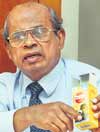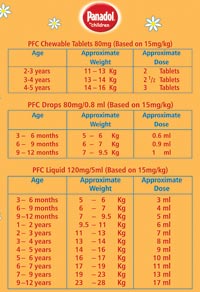| Weight before
age, when it comes to dosage
By Salma Yusuf
 How
a child grows varies from child to child as parents
well know. While one five-year-old may be rather plump,
well above the average weight for his/her age, another
may be small and thin. And yet when it comes to medicine,
they are both five-year-olds. How
a child grows varies from child to child as parents
well know. While one five-year-old may be rather plump,
well above the average weight for his/her age, another
may be small and thin. And yet when it comes to medicine,
they are both five-year-olds.
Taking such variations into consideration,
leading pharmaceutical manufacturer GlaxoSmithKline
(GSK) has launched a new paediatric dosage chart for
Paracetamol products based on weight rather than age.
For many years, paediatric dosing was carried out based
on age, but the current thinking is that dosage by weight
is more appropriate than dosing by age.
For over a year, a 15-member advisory
panel including renowned paediatricians in the country
and pharmacologists from the University of Colombo,
Dr. Dennis Aloysius, Dr. Nanda Amerasekera, Dr. J.V.
Ariyasinghe, Professor Dayasiri Fernando, Dr. Maxie
Fernandopulle, Professor Rohini Fernandopulle, Professor
S.P. Lamabadusuriya, Dr. B.J.C. Perera, Dr. Shalini
Sri Renganathan, Dr. Ajitha Wijesundera, Dr. Anula Wijesundera,
and Dr. Lakshman Weerasena with assistance from the
Medical Research Institute carried out extensive analysis
and deliberations to develop a dosage chart based on
weight for the paediatric range of the company's flagship
brand Panadol.
This was also done in the light of
background studies and findings from countries all over
the world, Brand Manager for GSK, Saroshika Jayawardena
told The Sunday Times.
 |
| Dr. Lucian Jayasuriya |
"Paediatric dosage based on weight
is a method that is followed by many countries in the
world and is effective. In Sri Lanka, however, since
most of the data was not readily available, much analysis
and consultation had to be done to arrive at the new
dosage system based on weight," GSK spokesman,
Dehan Seneviratne, Director Corporate Affairs and Medical
Marketing said.
The new dosage chart introduced by
GSK has been approved by the Sri Lanka Drug Regulatory
Authority. The DRA has made it the standard dosage system
for all paediatric Paracetamol products in the country.
"Panadol for Children is a household name and our
primary concern is to ensure that children are given
the proper dosage for effective treatment, " the
company's spokesman said.
The new paediatric dosage chart by
GSK was unveiled at a medical symposium held in Colombo
recently. 'Panadol for children' , Panadol's paediatric
range, was also re-launched at the event with new packaging
designed in compliance with the recent policies set
by the Sri Lanka Drug Regulatory Authority.
Speaking to MediScene Medical Advisor
for GSK, Dr. Lucian Jayasuriya, said, "Prior to
this new system being introduced, the problem with the
dosing by age gave rise to a two-fold problem. The first
was that in the event the child was of a higher weight
than that of the average child of the same age for which
the dose was prescribed, it would result in an under-dose
of the medication and thus the child will not be cured.
This would obviously cause anxiety in the mother who
would then give the child another dose which would result
in an over-dosage, the effect of which could give rise
to a host of other problems in the child.”
This is why dosage by weight is more
accurate than dosage by age, he said.
One of the problems encountered in
putting this system in place is the fact that many parents
know the weight of their child only upto the age of
one year because of regular check-ups and visits to
the paediatrician. Thus, Dr. Jayasuriya recommends that
the mother should weigh the child as a solution to this
problem. 'For practical purposes, we have formulated
a chart giving the age of the child, the corresponding
average weight and the prescribed dosage.’
Dr. C. Piyasena from the MRI had also
worked extensively on the project collecting data from
4709 households, 8000 children across 17 districts to
arrive at the average weights for a given age range
where the upper and lower centiles were looked at.
The expert panel took the following
factors as crucial in arriving at their conclusions-
The necessity to keep the dosage simple;
provision of satisfactory devices for accurate measurement
of the selected dosage (spoon, cup, tube, syringe etc)
and the desire to satisfy the needs of a multi-ethnic,
multi-lingual society in terms of equal emphasis given
to instruction labels on the packaging.
The Office of Medical Technology &
Supplies issued the new dosing schedule at the end of
last year and gave a six-month period from January 1,
2006 for implementation to all market authorization
holders of Paracetomol paediatric preparations.
‘We should have our own
model’
 Brand
Manager, GSK, Saroshika Jayawardena told MediScene
that though the 'dosage by weight' model was adopted
in many countries like Australia, India and Malaysia,
Sri Lanka had to have its own model since the
contributory factors that cause variations in
weight are different in each country and thus
each has to be unique to the country. Brand
Manager, GSK, Saroshika Jayawardena told MediScene
that though the 'dosage by weight' model was adopted
in many countries like Australia, India and Malaysia,
Sri Lanka had to have its own model since the
contributory factors that cause variations in
weight are different in each country and thus
each has to be unique to the country.
Asked how this new concept has
been communicated to the public, Mr. Jayawardena
said, "Firstly, we sent a medical marketing
team to brief doctors and chemists about the launch
of this new table. We approached them first because
mothers always seek their advice when looking
for cures for their children. The next group we
looked at were mid-wives.
“Finally, we identified
key locations to educate mothers, like waiting
rooms in clinics and vaccination clinics where
they were given posters and pamphlets on the new
system and its benefits."
|
|
